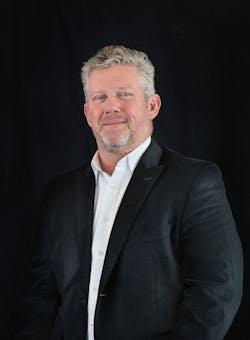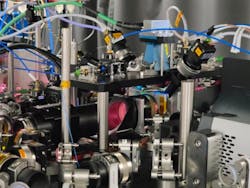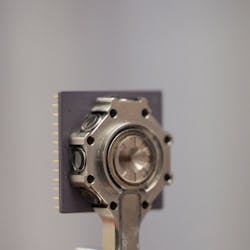For Scott Faris, CEO of Infleqtion, a quantum ecosystem company, taking risks is all part of the journey. In his words: “You jump off the cliff and figure it out on the way down.”
This philosophy has played out well for his career. From the start of his university studies in business information systems and an internship at a venture capital fund to his role today as CEO of a quantum company, Faris has been bridging the divide between what’s possible and profitable with an expert’s eye. His serial entrepreneurial focus has enabled him to invent and reinvent companies, falling into optics and photonics not because of his background, but in accord with it.
An entrepreneurial start
Faris had to find a way to finance his university studies, which led him to take a first-of-its-kind course on entrepreneurship. Through that program, he met a venture capital firm, and with the spirit of a startup leader, pitched the firm on why they needed to bring him onto their team. And hire him they did, as an intern, which quickly led to a full-time position that he worked in parallel with his university studies.
By today’s standards, Faris’ early career efforts at the fund would be dubbed “deep tech,” entirely focused on commercializing technologies coming out of academic institutions. In this role, Faris was able to partner directly with researchers to identify their technologies, map them to market opportunities, and launch new companies through the fund.
Edge of optics
Faris’ focus on spinning out businesses from the roots of academia led him to Florida after his graduation, where he ran a small venture fund affiliated with the University of South Florida. There, he continued his passion for working with emerging technologies rooted inside research institutions. Faris collaborated with technical leads to evaluate how they could engineer a company around their ideas. It was then, in another serendipitous turn of events, Faris was introduced to optics in the form of spectroscopy.
At the time, Ocean Optics was a startup looking for funding, and Faris helped raise its first round of financing. The founders’ goal was to disrupt the traditional sensors used in the spectroscopy market. It was a fast-growing business, and one of the investors invited Faris to take a full-time role with the organization. It was not an automatic yes—Faris had planned to keep on the venture capitalist (VC) path and become a partner in a fund. But he realized to advance with the skills he admired, he needed first-hand experience running companies. So he joined the Ocean Optics team.
Reflecting back on that time, Faris points to the phenomenal team as a pivotal part of his career. Mike Morris, the CEO, served as a sort of mentor to Faris, and he attributes his knowledge of optics—and raising daughters—to Mike’s leadership. Leeward Bean, another member of the leadership team, also influenced his path and was a fantastic role model in marketing, business and beyond.
Faris attests that the team at Ocean Optics encouraged pushing boundaries, challenging the status quo, and thinking differently—all attributes he was seeking in his career. It was a company with a mission centered on leading spectroscopy and sensing to the edge, which aligned with his passions and skillsets perfectly.
Rising to the challenge
That concept of taking technology to the next level followed him in his next position as CEO of Waveguide Solutions. There, he was greeted with a leader’s crisis at the start: His first day on the job as CEO was September 11, 2001.
With the nation in turmoil following the terrorist attacks, Faris was immediately thrust into the role of chief pivoter. Lack of access to chemicals and gases for cleanrooms meant that the company had to find a way to remain viable despite supply chain issues. Couple that with collapsing investments—their Series B evaporated within a week—and it was back to the drawing board for the team and the company.
Faris describes that time as a reconfiguring of strategy, technology, everything to respond to the new market reality. His experience working with VCs was critical at this point, and he pulled out all of the stops, convincing investors to have some patience and give them a little time to reconfigure.
And rebound they did. Faris transitioned the company from one serving telecom to a light-emitting diode (LED) packaging company. Strategically moving into the LED space at the advent of the LED age, finding ways to produce more light with better optics, creating better refractive indices, and doing all of it at scale led to strong business performance. Eventually, the company sold its intellectual property to a large LED company in South Korea, demonstrating the effectiveness of its strategic evolution.
As turbulent as that time was, Faris describes it as a seminal career moment, defining who he would become as a leader.
Broadening horizons
The successful sale of Waveguide Solutions’ technology behind him, Faris exited the photonics industry for a time. He applied his knowledge to a wide range of technology-based companies, including work with mRNA, personalized nutritionals, and noninvasive sensors for diagnostics.
As Faris points out, when it comes to business, the type of technology is secondary; the first point is to have a cutting-edge solution that addresses market needs. There’s commonality to businesses that base themselves on strong research, and Faris was able to take those organizations to the next level.
But that spirit of “what’s next” ultimately led Faris back to photonics, when he consulted to help friend Jason Eichenholz at his latest startup Open Photonics, and then later at Luminar Technologies. Ultimately, the potential of what awaited at Luminar drove him back into the industry.
It was the perfect storm of the right place, right time, right team, and right location. The fact that LiDAR was invented in Orlando, where the company was based, simply bolstered the opportunity. They had the ability to tap into a very deep knowledge base. And the work he had done at Ocean Optics set him on the trajectory for success in this new venture.
Faris reflects that the time he spent working through manufacturing and production challenges for spectroscopy gave him perspective as he transitioned over to Luminar. That forward knowledge helped him offer the team ideas on getting to a device that he describes as a thousand times more sophisticated than what they were producing with spectroscopy systems.
Fortunately, Faris has a passion for figuring out the manufacturing side of the coin. Luminar presented an opportunity to really push the boundaries of advanced manufacturing. The challenge was to look at LEDs and identify how to make them small, robust, affordable, and long-lasting—something he’d done with other technologies throughout his career.
The quantum realm
But in the spirit of serial entrepreneurism, Faris was drawn to a new opportunity. ColdQuanta, a quantum research firm, approached Faris and asked him to join the team. He looked at the massive challenge associated with bringing quantum technology to market and realized it was just a larger fish in a sea of what he had tackled throughout his career: Bringing research to reality in a scalable, efficient, and economic fashion. The potential was just too good to pass up.
When Faris joined ColdQuanta, he saw they had built an exceptionally talented team, and in the quantum field, the most valuable resource is people. He also realized they hadn’t fully crossed the path to scale and commercialize the core technology. He knew his unique skillset could help bridge that gap and bring research into the mainstream.
Faris believes quantum needs to live in the real world; it needs to be practical, live on the edge, be small, and robust. This is how it becomes useful to the world. And as he can attest, he’s there to build a global quantum information company.
Like it’s 1999
Faris compares this age of quantum progress to that of the telecom bubble of the 1990s. At the time, Bell Labs was fueling technological innovation, pushing the boundaries of research, and he views ColdQuanta—now Infleqtion—as the quantum equivalent today. In fact, the company has changed its name to reflect the fact that quantum itself is at an inflection point.
To carry the analogy further, back in 1999, the telecom industry transformed from serving voice needs to addressing data requirements. And today, data is overtaking the industry’s abilities to process and leverage it. The volume and speed of data have reached to the point where it’s broken, according to Faris, and this is precisely the problem he plans to address with quantum infrastructure.
With Infleqtion serving as a self-described quantum ecosystem and information company, Faris believes they can create plug-and-play quantum systems and subsystems as the key to the commercialization of quantum technology. They plan to develop quantum information, move quantum information, and eventually process quantum information—scaling the entire stack to create continuous connectivity.
Ultimately, it’s part of their business model to ensure their partners achieve commercial success as well, and to have Infleqtion continue on with them on as their component supplier. While the company will build its own systems, the Infleqtion team sees their partners as key to expanding their reach, from its base foundation to subsystems and other modules that will provide greater support to the industry.
The future promise of quantum will be met through an ecosystem of users gaining advantage from networked quantum-enabled sensors and computers, all with atomic clocks at their core. Infleqtion is building software and hardware products centered around precision frequency, next-generation positioning, navigation, and timing (PNT) systems, and distributed quantum processing nodes. These components, systems, and applications will empower users with highly accurate and faster navigation, disaster detection, environmental monitoring, and data and energy networks.
With great data comes great possibility
This is the reason the quantum realm is such a high-stakes game for Faris. It’s new. It’s the next evolution of hardware platforms. It’s what’s beyond microelectronics in many ways, and it’s hard, insanely hard. But this is where Faris’ resilience comes into play. His philosophy is that you have to tackle the hard problems, not run from them.
And he’s addressing one of the industry’s biggest challenges. Because with great data comes great possibility, but great data needs more to draw out its potential. And for their part, Faris and Infleqtion are here to make sure that continues to happen.



